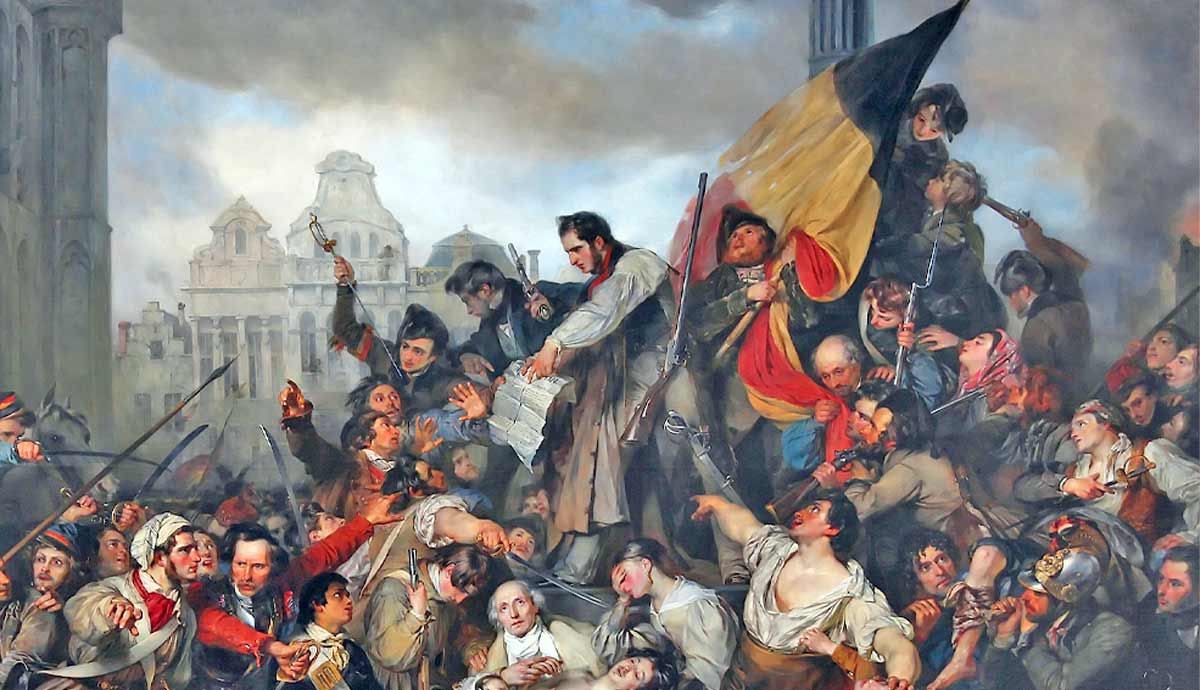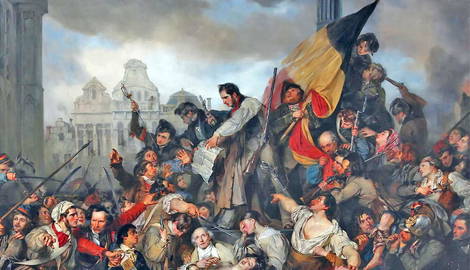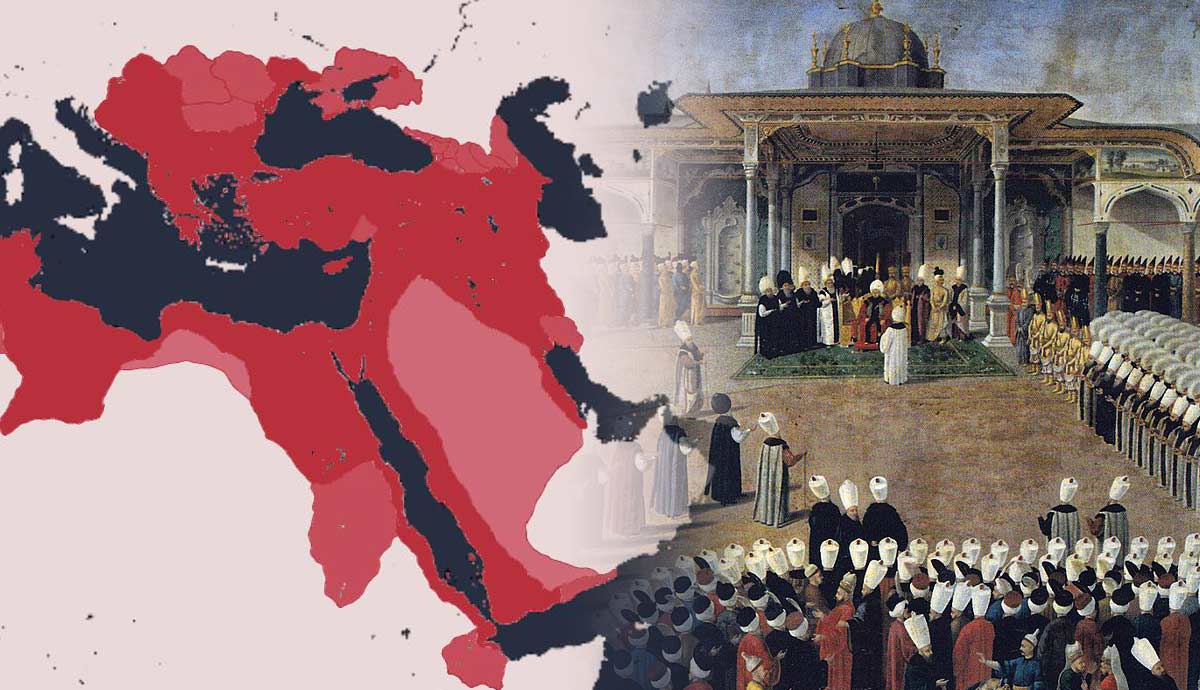
Historian Roderick Beaton points out that many historians describe the first few decades on either side of the year 1800 as the “Age of Revolution.” One of the Age of Revolution’s more unexpected chapters occurred in 1830-1831 with the Belgian Revolution. In 1830, France’s Foreign Minister Charles Maurice de Talleyrand claimed, “There are no Belgians, there never have been, and there never will be: there are Frenchmen, Flemings or Dutchmen (which is the same thing) and Germans.” Yet, to Talleyrand’s surprise, thousands of people mobilized that very year to fight for the recognition of an independent Belgium distinct from the Netherlands and France.
Background: Belgium in the Age of the French Revolution

Belgium was known as the Southern or Austrian Netherlands at the end of the eighteenth century. It thus formed part of the Holy Roman Empire, ruled by the Habsburgs in Vienna. Many communities in the Austrian Netherlands prospered during the reigns of Empress Maria Theresa and her son, Joseph II, in the second half of the eighteenth century.
Moreover, some areas of present-day Belgium, like the city of Liège, were separate entities within the Holy Roman Empire. In other words, there was hardly a Belgian state as we might recognize today at the end of the eighteenth century. However, this began to change once the French Revolution gripped neighboring France in 1789.
Inspired by the French Revolution, Belgian activists began to push for a republican government in a united Belgium. In Liège, rebels drove the ruling prince-bishop from power and proclaimed a republic.
Neighboring Brabant in the Austrian Netherlands rebelled against Emperor Joseph II’s centralizing policies. A rebel army defeated the Austrians at Turnhout in October 1789. As the Austrians retreated, rebels proclaimed a new state called the United Belgian States (January-December 1790).
However, academic Samuel Humes explains that the United Belgian States fractured between conservative and liberal factions. Moreover, the Austrians returned in force and soon reconquered the region. Nevertheless, Austrian rule proved short-lived.
For instance, between 1792 and 1794, present-day Belgium seesawed between Austrian and French control. However, revolutionary France gained control of Belgium after defeating the Austrians at Fleurus in June 1794.
French Revolutionary and Napoleonic Belgium

Belgium experienced sweeping social, political, and economic changes like many places conquered by revolutionary or Napoleonic France. Historian Michael Rapport notes that France annexed Belgium in October 1795.
Napoleon presided over sweeping changes in Belgian society. For instance, historian Alexander Grab explains that the legal codes implemented under Napoleon became the basis for subsequent Belgian legal systems. The French also supported the region’s industrialization.
However, French rule was far from entirely welcomed by the population. For example, many resented the harsh demands of forced military service in Napoleon’s seemingly endless wars.
From Vienna to Waterloo

Members of the victorious Sixth Coalition against Napoleon (including Austria, Britain, Prussia, and Russia) convened in Vienna in 1814 to plan Europe’s future without Napoleonic France. They even permitted a French delegation representing the recently restored Bourbon monarchy to join negotiations at the Congress of Vienna.
The diplomats and rulers gathered at Vienna shared a primary goal: ensuring no country would dominate Europe as Napoleon’s France had in previous years. In other words, they hoped to restore the balance of power.
One way to do this was to create substantial buffer states between France and its former rivals like Austria and Prussia. The Netherlands proved to be one of the beneficiaries of the desire to establish stronger buffer states on France’s borders.
Indeed, the Netherlands received present-day Belgium and became the United Kingdom of the Netherlands in 1815.
However, Napoleon’s dramatic escape from exile on the Mediterranean island of Elba and return to power in France in March 1815 (the Hundred Days) rattled the diplomats and rulers present at the Congress of Vienna. Soon, a seventh coalition headed by Britain formed to defeat Napoleon.
A British and Allied army, including significant numbers of Dutch and Belgian troops, joined by a Prussian army, defeated Napoleon near Brussels at Waterloo in June 1815.
The United Kingdom of the Netherlands

King William or Willem I of the United Kingdom of the Netherlands had reason to be optimistic in the kingdom’s early years. For example, the region had begun to industrialize, and several cities like Verviers and Antwerp prospered during the Napoleonic Wars.
However, developments from the Napoleonic era also challenged the kingdom’s survival. William’s linguistic policies, for instance, angered many in the Flemish provinces in the south. The Dutch king wanted to make Dutch the official language of the traditionally Dutch-speaking Flemish provinces of the former Austrian Netherlands.
While this might appear like a non-issue, local elites took offense at King William’s proposed linguistic policy. The reason is that under Napoleonic French rule, many Flemish elites spoke French as their first language and now resisted the possibility of official linguistic changes imposed from the royal palace.
Moreover, King William was a Protestant Calvinist as were many of his subjects in the northern half of the kingdom. However, the population of the southern half, whether Dutch or French-speaking, was united by a shared Catholic faith.
King William and his court did little to earn the sympathy of those living in the southern provinces. Indeed, the Dutch went as far as to renege on the promise to appoint an equal number of senior administrative officials from the north and south of the kingdom.
By 1828, secular and religious groups from the South advocating for reform presented a united front against King William I’s government. Economic problems would soon combine with these calls for reform to spark a full-scale rebellion.
Revolution

Reformers did not have to wait long for dramatic change. Indeed, a poor harvest in 1830 and the outbreak of revolution in Paris that July fanned the flames of revolt in Belgium.
Belgium’s revolution began in earnest following a performance of Daniel Auber’s opera, La Muette de Portici, on August 25, 1830. Riots occurred in Brussels as theatergoers rushed out to join growing mobs of protesters angered by tight restrictions on food supplies and other issues. While the opera had been performed in honor of King William’s birthday, the people of Brussels were not in the mood to celebrate their monarch.
Dutch Crown Prince William attempted to restore order in Brussels by mediating between the rebels and his father. However, the arrival of volunteers from across Belgium and King William’s refusal to negotiate put the young crown prince in a difficult position. By late September 1830, Belgian rebels forced Dutch troops led by King William’s second son, Prince Frederik, to evacuate Brussels.
A provisional government led by Charles Rogier declared Belgian independence from the United Kingdom of the Netherlands on October 4, 1830. In November 1830, elections were held for the first Belgian assembly called the National Congress.
Rulers and diplomats across Europe did not expect a challenge to the post-Napoleonic map of Europe to come from the United Kingdom of the Netherlands. When it did, many, like Austrian Chancellor Clemens von Metternich, expected Europe’s leaders to unite and support King William I’s efforts to reclaim Belgium.
However, to Metternich’s disappointment, this did not happen. European leaders convened in London to discuss matters related to Belgium, and soon, British and French leaders expressed sympathy for an independent Belgian state.
Leopold I, King of the Belgians

In February 1831, Belgium’s National Congress ratified a constitution that made the country a constitutional monarchy. Belgian leaders hoped that embracing a constitutional monarchy would satisfy Europe’s conservative anti-revolutionary leaders like Metternich and earn their recognition of an independent Belgium.
Prince Leopold of the German state of Saxe-Coburg became the first King of the Belgians (1831–1865). Leopold proved a suitable candidate as he was closely related to the British royal family and won recognition as an officer in the Imperial Russian army during the Napoleonic Wars.
While many of Europe’s rulers soon recognized an independent Belgium, King William I refused. Instead, the Dutch ruler prepared a military campaign to retake his former southern provinces.
However, the campaign proved as short-lived as its name, the Ten Days’ Campaign, suggests. It did not result in a restored United Kingdom of the Netherlands. Despite a quick victory on the battlefield over Belgian troops, Dutch forces agreed to depart in the face of a French army determined to support Leopold’s new kingdom.
Dutch troops evacuated Antwerp, their last base in Belgium, in 1832. But, King William did not recognize Belgian independence until signing the Treaty of London in April 1839.
Legacy

Belgium’s 1830 revolt was closely linked to the July 1830 Revolution in France. Both revolutions symbolize the growth of Romanticism in European society in the first decades of the nineteenth century. Put simply, Romantics emphasized emotion and feelings to understand the world.
Art, literature, and music, including performances of operas like La Muette de Portici in Brussels, show us how emotion embodied by Romanticism shaped political movements like the 1830 Belgian Revolution.
Although France’s 1830 revolution is more well-known, Belgium’s role in the revolutionary climate of the 1830s and 1840s in Europe should not be forgotten. Indeed, Belgium’s 1830 rebellion stands out as an example of a successful revolt against the post-Napoleonic conservative order engineered by Metternich.










